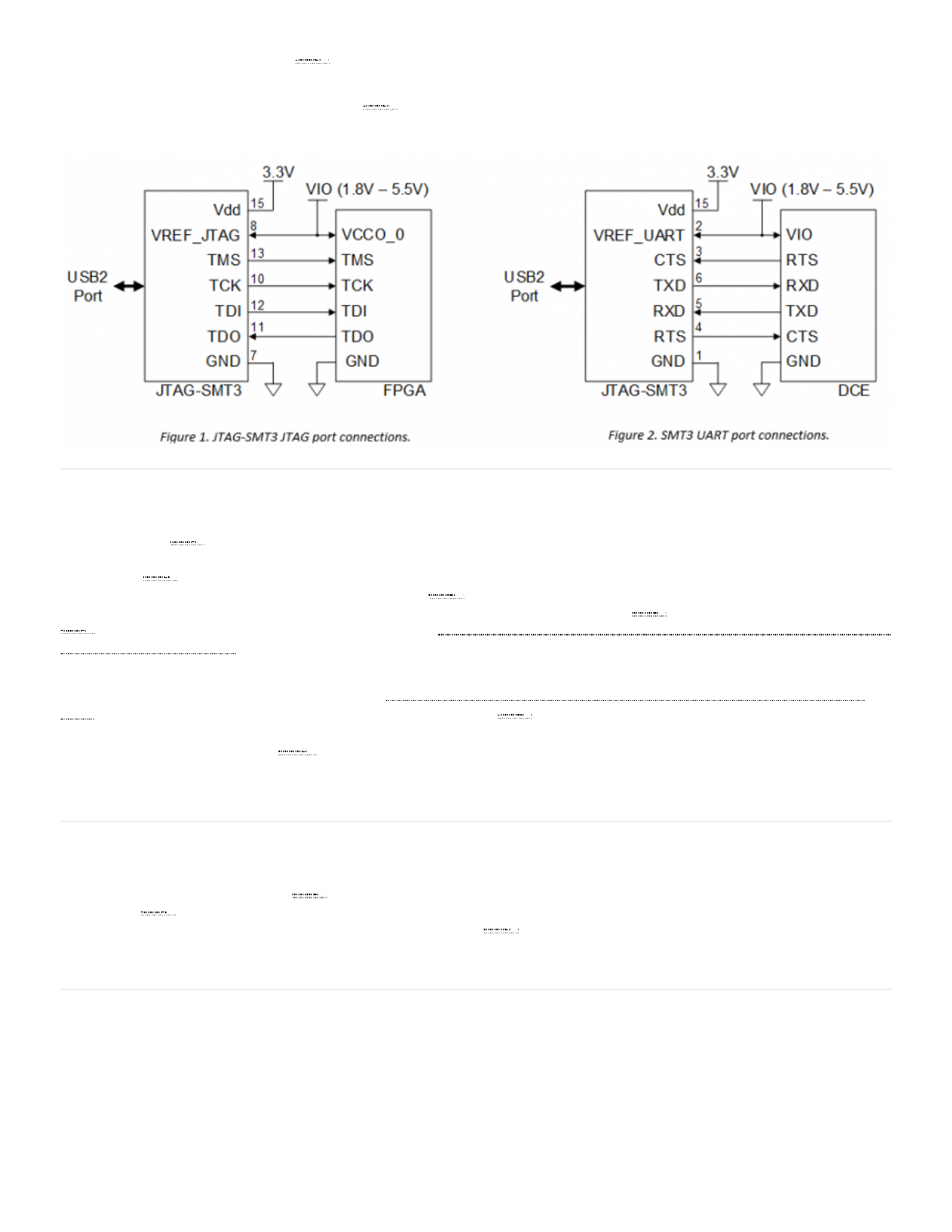Data Sheet

10/3/2018 JTAG-SMT3-NC Reference Manual [Reference.Digilentinc]
https://reference.digilentinc.com/reference/programmers/jtag-smt3/reference-manual 6/16
Note: Keep the impedance between the SMT3-NC () and FPGA below 100 Ohms to operate the JTAG at maximum speed. Note: If series resistors are used, they
should be placed near the transmitting end in order to minimize reflections.
In addition to supporting JTAG, the JTAG-SMT3-NC () also features a UART Interface that allows communication with UART peripherals
(see Fig. 2). The UART interface is presented as a virtual com port on the host PC, supports baud rates up to 12Mbaud, and has an
independent voltage reference which allows it to interface with devices operating at voltages between 1.8V and 5.5V.
The JTAG-SMT3-NC () has been designed to work seamlessly with Xilinx’s ISE® (iMPACT, ChipScope, EDK, and eFuse) and Vivado
tool suites. The most recent versions of ISE and Vivado include all of the drivers, libraries, and plugins necessary to communicate with the
JTAG-SMT3-NC (). At the time of writing, the following Xilinx software included support for the SMT3: Vivado 2017.1+, Vivado 2016.1+,
Vivado 2015.1+, Vivado 2014.1+, and ISE 14.1+. The SMT3-NC () is also compatible with ISE 13.1 - 13.4; however, these versions of ISE
do not include all of the libraries, drivers, and plugins necessary to communicate with the SMT3-NC (). In order to use the JTAG-SMT3-
NC () with these versions of ISE, version 2.5.2 or higher of the Digilent Plugin for Xilinx Tools (http://store.digilentinc.com/digilent-plugin-
for-xilinx-tools-download-only/) package must be downloaded from the Digilent website and the ISE13 plugin must be manually installed as
described in the included documentation.
In addition to working seamlessly with all Xilinx tools, Digilent’s Adept software (http://store.digilentinc.com/digilent-adept-2-download-
only/) and the Adept software development kit (SDK) support the SMT3-NC () module. For added convenience, customers may freely
download the SDK from Digilent’s website. This Adept software includes a full-featured programming environment and a set of public
application programming interfaces (API ()) that allow user applications to directly drive the JTAG chain.
With the Adept SDK, users can create custom applications that will drive JTAG ports on virtually any device. Please see the Adept SDK
reference manual for more information.
When customers use the JTAG-SMT3-NC () to interface the scan chain of Xilinx’s Zynq platform, they should connect the PS_SRST_B pin
of the SMT3-NC () to the Zynq’s PS_SRST_B pin. This connection allows the Xilinx Tools to reset the Zynq’s processor core at various
times during debugging operations. The PS_SRST_B pin on the SMT3-NC () is driven by an open drain buffer that is capable of sinking up
to 32mA of current. Customers who connect this pin must provide an external pull-up to the appropriate supply rail. A pull-up resistor
between 1K - 100K Ohms is recommended. Please see the following “Application Examples” section for more information.
The VBUS_DETECT pin is used by the USB controller to determine when VBUS is present. When a logic ‘0’ is detected on this pin, the
USB controller is forced into suspend mode. This prevents the SMT3-MC from forcing current down the USB lines when the host or the
hub is powered off. Additionally, it results in reduced current consumption from the module. Connect VBUS to the VBUS_DETECT pin
using a resistor divider, similar to the one in Fig. 3 shown below.
Software Support
PS_SRST_B Pin
VBUS_DETECT Pin










